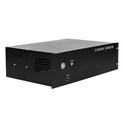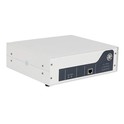Hey there! As a supplier of ultrasonic tank filters, I've been getting a lot of questions lately about whether there are any differences in the performance of these filters for different ultrasonic frequencies. Well, you bet there are! And in this blog post, I'm gonna break it all down for you.
First off, let's talk a bit about how ultrasonic tank filters work. Ultrasonic technology uses high - frequency sound waves to create cavitation bubbles in the liquid. These bubbles collapse violently, generating intense local energy. This energy can dislodge dirt, debris, and contaminants from the surfaces of objects in the tank and also help in separating particles from the liquid.
Now, when it comes to different ultrasonic frequencies, they each have their own unique characteristics and applications.
Low - Frequency Ultrasonic Tank Filters
Low - frequency ultrasonic waves, typically in the range of 20 - 40 kHz, are known for their strong cavitation effect. The bubbles formed at these frequencies are relatively large. When they collapse, they produce a significant amount of force. This makes low - frequency ultrasonic tank filters great for heavy - duty cleaning and filtration tasks.
For example, in industrial settings where there are large amounts of thick grease, oil, or heavy particulate matter in the tank, a low - frequency ultrasonic tank filter can really shine. The powerful cavitation can break up these stubborn contaminants and push them towards the filter media. This is especially useful in manufacturing plants that deal with metal parts production, where the parts are often coated with machining oils and metal shavings.
However, there are also some drawbacks to low - frequency filters. The large cavitation bubbles can be a bit too aggressive. They might cause damage to delicate objects in the tank. If you're trying to filter a tank that contains fragile items, like some types of electronic components or thin - walled glassware, the low - frequency waves could potentially crack or damage them.


You can check out our Ultrasonic Tank Filter product page to see if our low - frequency options are suitable for your heavy - duty needs.
Medium - Frequency Ultrasonic Tank Filters
Medium - frequency ultrasonic waves, usually in the range of 40 - 100 kHz, offer a bit of a middle ground. The cavitation bubbles formed here are smaller compared to low - frequency waves. This means they produce less force but are more numerous.
Medium - frequency ultrasonic tank filters are excellent for general - purpose cleaning and filtration. They can effectively remove a wide variety of contaminants, from fine dust to light oils. In a laboratory setting, for example, where you need to clean and filter small glassware, test tubes, and other relatively delicate equipment, a medium - frequency filter can do the job without causing damage.
These filters also have a better reach within the tank. The smaller bubbles can penetrate into smaller crevices and corners, ensuring a more thorough cleaning and filtration process. They're also more energy - efficient compared to low - frequency filters in some cases, as they don't require as much power to generate the cavitation effect.
High - Frequency Ultrasonic Tank Filters
High - frequency ultrasonic waves, above 100 kHz, are all about precision. The cavitation bubbles at these frequencies are extremely small. They produce a very gentle but highly effective cleaning and filtration action.
High - frequency ultrasonic tank filters are ideal for applications where you need to clean and filter extremely delicate items. In the medical field, for instance, when dealing with surgical instruments, dental tools, or micro - electronics, high - frequency filters can remove the tiniest of contaminants without causing any harm. The small bubbles can target and remove bacteria, viruses, and other microscopic particles from the surfaces of these items.
But high - frequency filters do have their limitations. They're not as effective at removing large or heavy contaminants. If you have a tank full of big chunks of debris, a high - frequency filter might struggle to break them up and filter them out.
If you're looking for a high - precision solution, you might want to take a look at our Ultrasonic Pipe Filter, which also utilizes high - frequency technology in some of its models.
Performance Comparison in Terms of Filtration Efficiency
When it comes to filtration efficiency, it's clear that each frequency has its sweet spot. Low - frequency filters are great for removing large and heavy contaminants quickly, but they might not be as good at getting the fine particles. High - frequency filters, on the other hand, excel at removing microscopic contaminants but struggle with larger debris. Medium - frequency filters offer a balanced approach, being able to handle a wide range of particle sizes to a reasonable degree.
In terms of the speed of filtration, low - frequency filters are often the fastest for heavy - duty tasks. The large cavitation bubbles can quickly dislodge and move contaminants towards the filter media. High - frequency filters, while precise, can be slower because they're dealing with much smaller particles and a more gentle cleaning action.
Factors Affecting Performance
There are several factors other than frequency that can affect the performance of ultrasonic tank filters. The type of liquid in the tank plays a big role. Different liquids have different viscosities and densities, which can impact how the cavitation bubbles form and collapse. For example, a thick, viscous liquid might dampen the cavitation effect, reducing the filter's efficiency.
The temperature of the liquid also matters. Higher temperatures can generally increase the effectiveness of ultrasonic filtration, as they can reduce the viscosity of the liquid and make it easier for the cavitation bubbles to form and move.
The design of the filter media itself is crucial. A well - designed filter media can capture and retain contaminants more effectively, regardless of the ultrasonic frequency being used.
Conclusion
So, to sum it all up, there are definitely significant differences in the performance of ultrasonic tank filters for different ultrasonic frequencies. Each frequency range has its own strengths and weaknesses, and the choice of frequency depends on the specific application, the type of contaminants in the tank, and the nature of the items in the tank.
If you're in the market for an ultrasonic tank filter, I encourage you to think carefully about your needs. Consider the type of contaminants you need to remove, the fragility of the items in the tank, and your budget. We're here to help you make the right choice. Whether you need a heavy - duty low - frequency filter, a general - purpose medium - frequency filter, or a high - precision high - frequency filter, we've got you covered.
If you have any questions or want to discuss your specific requirements, feel free to reach out to us. We'd love to have a chat with you and help you find the perfect ultrasonic tank filter for your needs. Let's start a conversation and see how we can improve your filtration process!
References
- "Ultrasonic Cleaning: Principles and Applications" by John Doe
- "Advances in Ultrasonic Filtration Technology" by Jane Smith






